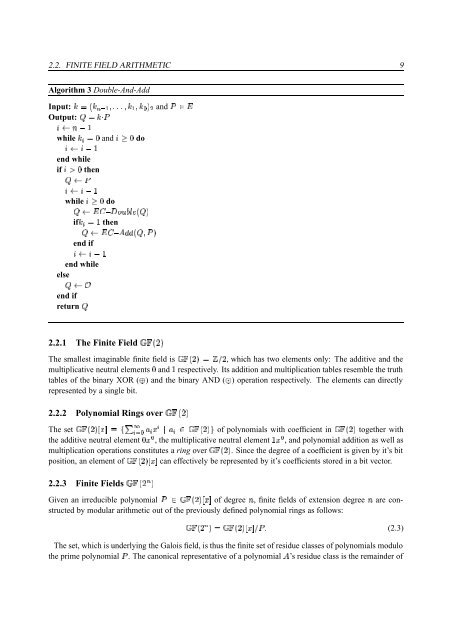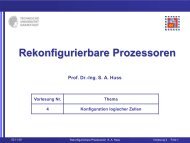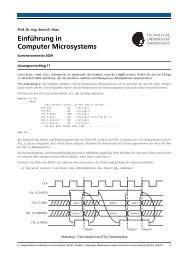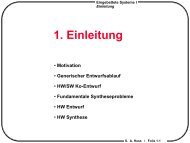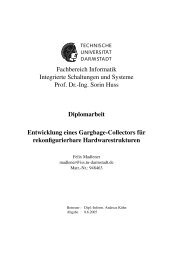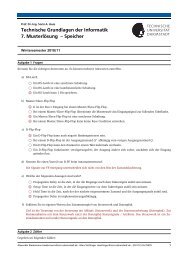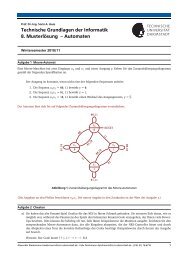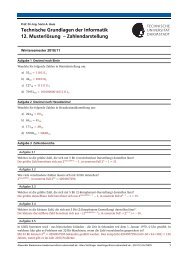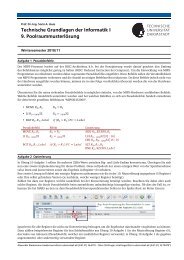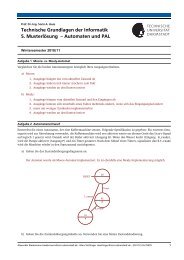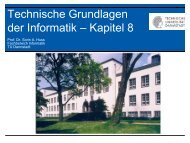FPGA based Hardware Accleration for Elliptic Curve Cryptography ...
FPGA based Hardware Accleration for Elliptic Curve Cryptography ...
FPGA based Hardware Accleration for Elliptic Curve Cryptography ...
You also want an ePaper? Increase the reach of your titles
YUMPU automatically turns print PDFs into web optimized ePapers that Google loves.
2.2.2 Polynomial Rings over·7¸À¹4»<br />
2.2. FINITE FIELD ARITHMETIC 9<br />
Algorithm 3 Double-And-Add<br />
Input:<br />
6 = Y@\\\S@AYZ@AP®S3 and<br />
Ë /<br />
m ¯ _ c ¯<br />
end while<br />
I<br />
then<br />
Vwm <br />
if¯:´<br />
m ¯ _ c ¯<br />
6 ¯ m°( _ c<br />
Output:V<br />
6²I and¯³ I<br />
do<br />
while±<br />
while¯³ I<br />
do<br />
/ } _ €Hµ r>[xtPuV…<br />
if ± 6 c then<br />
Vwm<br />
/ } _ v-{P{ uV§@g…<br />
end if<br />
Vwm<br />
m ¯ _ c ¯<br />
end while<br />
else<br />
end if<br />
VwmoT<br />
2.2.1 The Field·§¸º¹»<br />
Finite<br />
The smallest imaginable finite is- 6½¼ †¦ field , which has two elements only: The additive and the<br />
multiplicative elementsI<br />
andc neutral respectively. Its addition and multiplication tables resemble the truth<br />
tables of the binary (¾ XOR ) and the binary (¿ AND ) operation respectively. The elements can directly<br />
represented by a single bit.<br />
returnV<br />
sethÁ5à6 J¦ÄÆÅ ±ÈÇÉ® ;P±K5 ± L`;P± E -AR The of polynomials with in: coefficient together with<br />
the additive elementI<br />
5 ®<br />
neutral , the multiplicative elementch5<br />
®<br />
neutral , and polynomial addition as well as<br />
multiplication operations constitutes a over ring . Since the degree of a coefficient is given by it’s bit<br />
position, an ofhÁ5. element can effectively be represented by it’s coefficients stored a bit vector.<br />
2.2.3 Fields-·‰¸º¹ »<br />
Finite<br />
Given an irreducible E hÁ5. polynomial of ( degree , finite fields of extension ( degree are constructed<br />
by modular arithmetic out of the previously defined polynomial rings as follows:<br />
6 hÁ5.ÂK†k\ (2.3)<br />
The set, which is underlying the Galois field, is thus the finite set of residue classes of polynomials modulo<br />
the prime polynomial . The canonical representative of a polynomialv<br />
’s residue class is the remainder of


